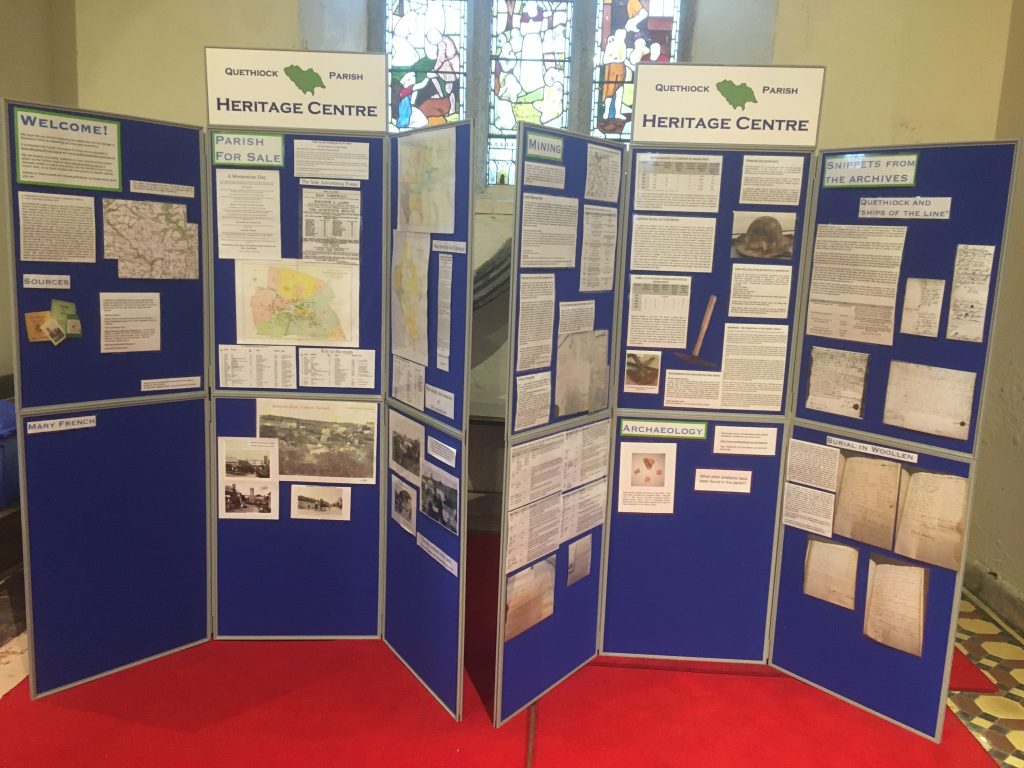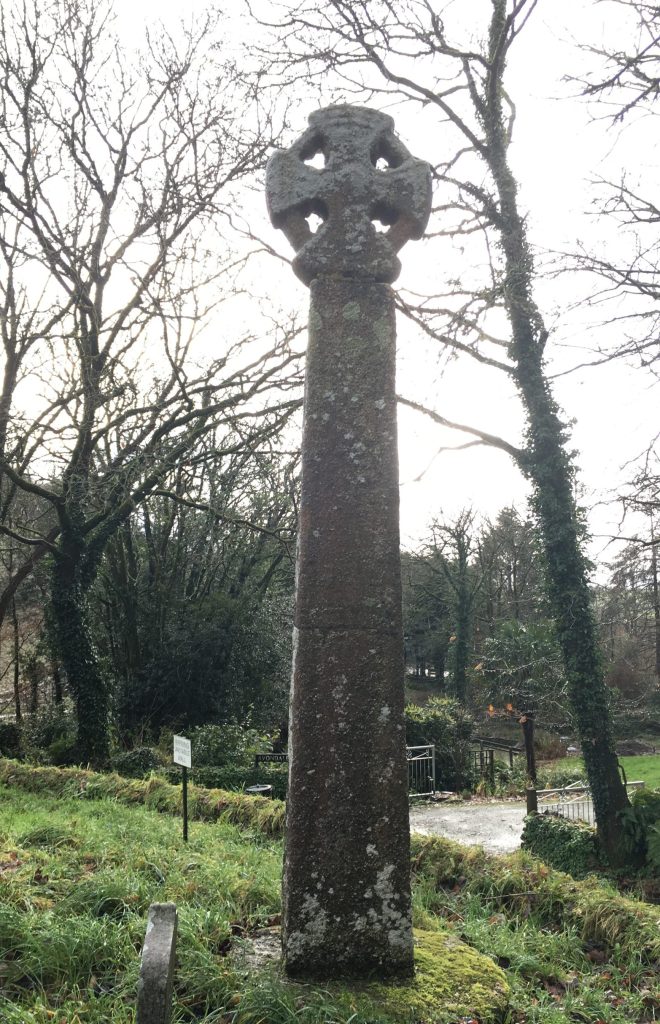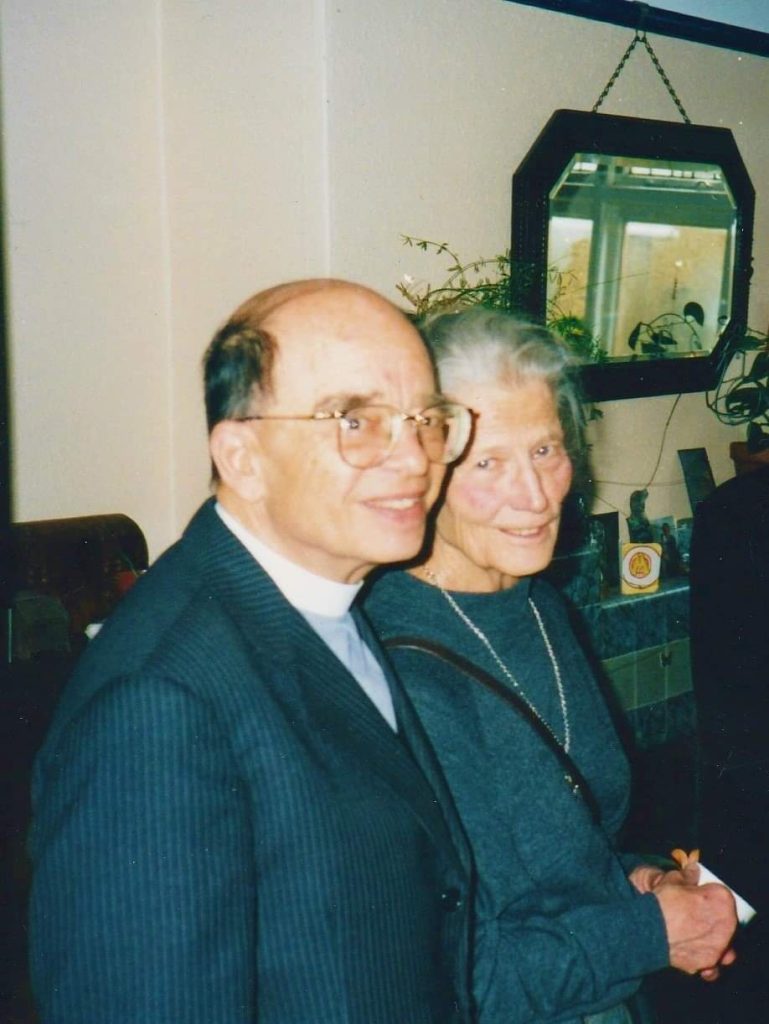
Heritage
If you think you may have relatives who lived in Quethiock in the past and would like to find out more, please go to our Genealogy page.
QUETHIOCK PARISH HERITAGE CENTRE

The Quethiock Parish Heritage Centre in the church has been refreshed for 2024. The large display boards now carry articles on the Kelly Family, Medieval Manors, The Bodulgates, Quethiock Quakers, Samuel Rogers, Archaeology, the Geology of Quethiock and The Mason’s Arms. Each year, displays are prepared from the previous year’s researches and talks given by QPLHG members. Some of the presentations are available to view below. From time to time different subject matter will be added. The Heritage Centre can be viewed any time the church is open, which is every day.
THE CHURCHYARD CROSS

At over 4m (13ft) high, Quethiock’s imposing churchyard cross is one of the tallest and most complete in Cornwall. It was found in 1881 in four pieces in the churchyard. The base and head were buried deep in the ground near the southern boundary, while the shaft was found in two pieces, in use as gateposts to a disused entrance to the churchyard. The four pieces were fixed together and the monument erected where it still stands, in a place which was thought to be close to its original location.
The cross has a ring head with trefoil-shaped holes – a distinctive feature linking it to other less well-preserved monuments at nearby Pelynt and more distant Padstow. The shaft is decorated with foliage and interlacing strands although because the decoration is in very low relief and is so worn it can be difficult to make out. The cross is the oldest visible feature at the church site, having been originally carved and set up in the late 10th or 11th century, before the Norman Conquest. More detailed information can be found here.
Article kindly provided by Ann Preston-Jones and Andrew Langdon.
LT. FREDERICK ROBERTSON FLETCHER
There is a memorial to Lt. Fletcher on the north wall of the church. Rather intriguingly it refers to the Battle of Lagos. The full story is here:
CHURCH AND GRAVEYARD MEMORIALS
A project to enable visitors to locate memorials in the church and churchyard has been completed and a folder of maps and alphabetical list of names is available at the back of the church. Full instructions are included.
The name list, together with information regarding unidentified and missing memorials and reconstructed fragments can be found on the Church Memorials page.
MEDIEVAL MANORS AND THE LOST CHAPEL OF TRECORME
There is a local story that there was a chapel at Trecorme, moreover that it was on a particular site and was connected to a Holy Order of Nuns. Additionally, a previous occupant had stated that there was a moat lined with cobbles, cellars and a medieval door that had been moved to the farmhouse. A moated enclosure is visible but nothing else and there is no documentary evidence for such a chapel. This was the starting point for a fascinating research opportunity involving the striving of medieval West Country families to build wealth and reputation at a time when life was by no means a certain commodity, the importance of religion to every aspect of society at a level completely alien today, and a highly structured feudal society as it broke down into the development of the Yeoman classes. All of this happening in Quethiock.
These are the main points (use this link to the full article as it appears on the QPLHG display – pages 17 and 27 are intentionally blank)
- Quethiock does not appear in the Domesday Survey of 1087, but the manors of Hammett and Penpoll do
- Penpoll held the advowson (right to nominate the Rector and collect the rectorial tithes) to St. Hugh’s
- The Norman church may well have been built by the Lord of Penpoll
- The advowson went to the Haccombes of Devon with the marriage of Cecily de Penpoll and Jordan de Haccombe
- The Bodulgates lived at Trecorme in the 1400s and did have a chapel there.
- There is no reason why the chapel should not have been on the site suggested, but odd that no fields are name ‘chapel close’ for example.
- No evidence was found of a religious order at Trecorme
- In the fourteenth century, it was common for manors such as Penpoll and Trecorme to have private chapels
- The chapel at Trecome is contemporary with the construction of the north aisle in St. Hugh’s, and the loss of the north Trecorme transept.
- There is documentary evidence of manorial customs continuing until the nineteenth century eg which of Hepwell or Trehunsey or Trecorme mills were to be used
- Trehunsey Manor was formed from Penpoll
QUETHIOCK QUAKERS
Astonishingly, there were Quakers in Quethiock as George Fox began touring the English countryside preaching to all that would hear him. Quakers in Quethiock belonged to the Eastern Division Monthly Meeting and met initially in members’ houses, in Quethiock, Germans (sic), Stoke Climsland, and Liskeard. The Mens’ Monthly Meeting book for the Easter Division can be accessed at Kresen Kernow and gives intricate detail of proceedings including lists of those attending. Another source is the Book of Sufferings (available online). Quakers in Cornwall recorded how they were persecuted – beatings, confiscation of property and imprisonment. One Thomas Deeble of Quethiock suffered greatly and actually died in Bodmin Jail – of natural causes though. Use this link to read the full article as it appears on the QPLHG display. (Photographs of original documents held at Kresen Kernow have been removed as permission has not been sought for this publication. Permitted photographs can be seen on the display in the church.)
ST. CADOC’S DAY
24th January is St. Cadoc’s Day and was traditionally the Feast Day of Quethiock Parish. Up until the 1920s, a cattle fair was held on the last Monday of January as the last remnant of the customary Feast.
INTERNATIONAL DAY OF COMMEMORATION IN MEMORY OF THE VICTIMS OF THE HOLOCAUST

27th January is the International Day of Commemoration in Memory of the Victims of the Holocaust. Quethiock has its own connection with the Holocaust as evidenced by this plaque just inside the main church door. It reads: In memory of M.U. Dr. Erich Schneider of Aussig Bohemia. Born there on 20th July 1889. Believed to have died in Auschwitz Concentration Camp in October 1944. He was comforted to know that Quethiock had given a home to his son.
The son was Johann Schneider and his Quethiock ‘home’ was with the Reverend Lintell and his family at the Vicarage. Johann was born on October 25th 1921 and his sister, Anna, arrived on 29th January 1924. A note says that Johann spent the school holidays with the Revd. Lintell’s family, although he must have been almost 18 years old when WW2 broke out. His father, a Doctor of Music, died at Auschwitz in October 1944. Dr. Schneider’s mother, Minna Schneiderova, died at Terezin Camp on 6th January 1943, however, his wife, Marketa survived Terezin and settled in London where she died in August 1979.

This is a photograph of Johann and Barbara Schneider which was taken at a family gathering in 1993 by Nick Lintell, grandson of Revd. Lintell.
Johann had a career as an economist and statistician and rose to be Chief statistician of the Civil Service ( Treasury & Central Statistical Office ). He also gained a doctorate in Lutheran theology and was Assistant Pastor at St. Anne’s Lutheran Church in London from 1987-2005. He married Barbara Louise Von Kalckstein and, according to the Revd. Lintell’s family, had two children.
Whoever placed the plaque in the church is currently unknown.